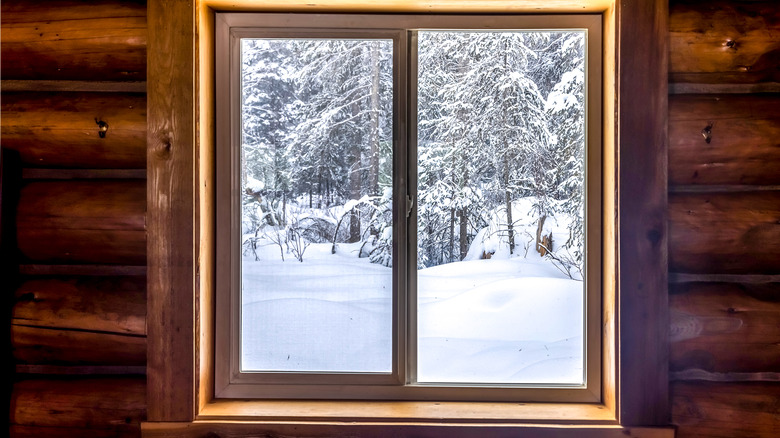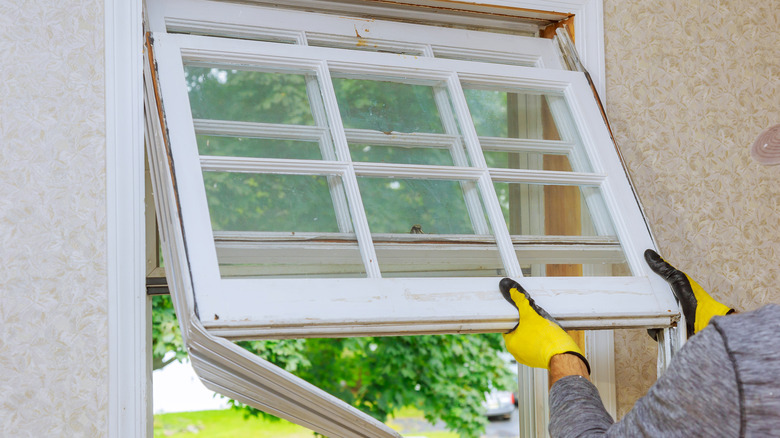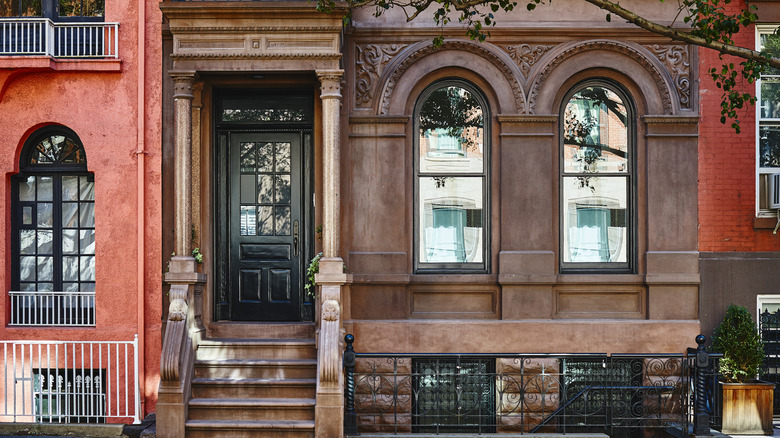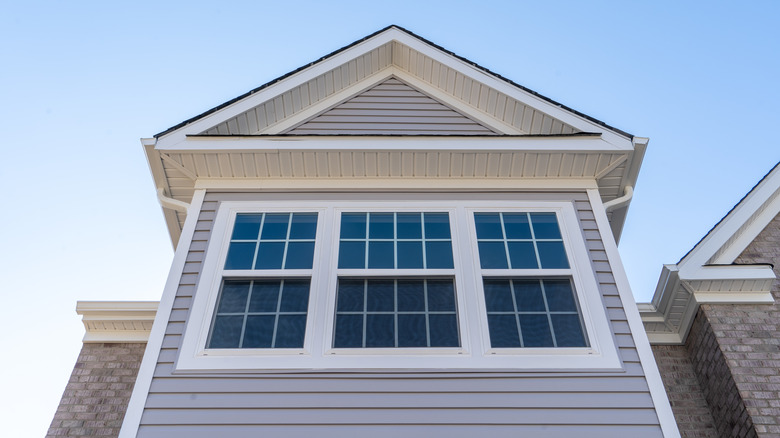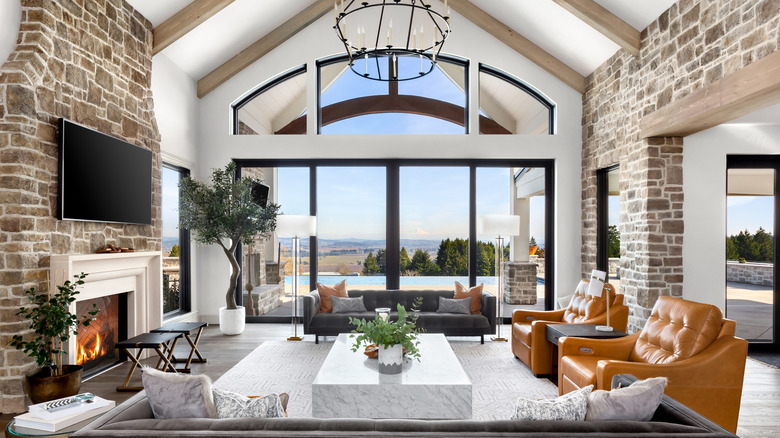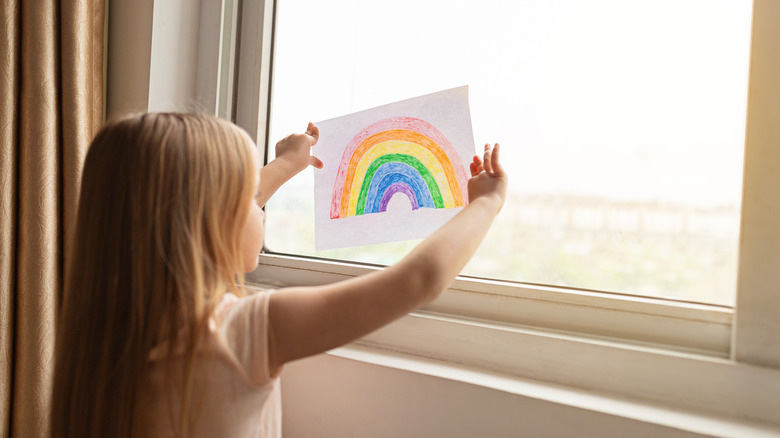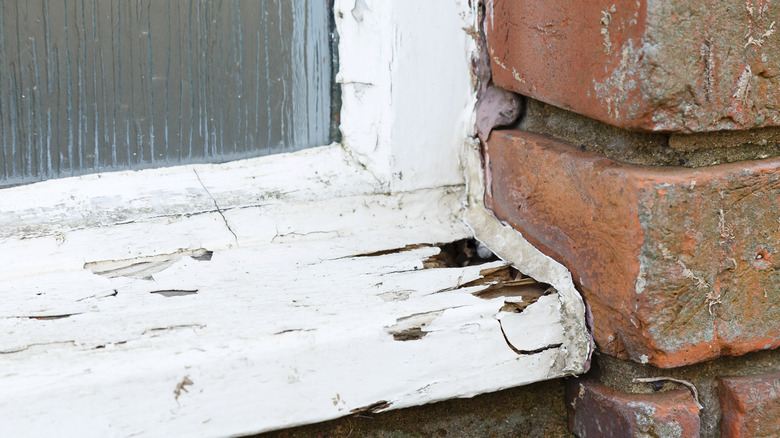How Much Does It Cost To Replace A Window?
A home's windows provide many things: natural lighting, good airflow, and insulation. Plus, they serve as a centerpiece for your exterior, giving your home a bit of style. Additionally, there are many reasons to replace existing windows: the glass broke, you want a new look, or you're hoping to steady those skyrocketing energy bills — 30% of the warm or cold air circulating through your house gets lost through windows and doors. New windows can even increase your property value, especially if they are energy efficient. If you have an older house, new windows can lessen your never-ending projects; they are designed for less maintenance and require little repainting and refinishing, per FOA Home Improvement.
Replacing a window might seem overwhelming since it involves making several decisions: What window design do you want? What type of material are you looking for? Do you want something that's energy efficient? Who should install it? Each one of these factors impacts your project's time and cost (via Energy.gov).
Average costs for window installation vary widely — the national average is somewhere between $100 and $650 per window, according to Bob Vila. That's without labor, which will add on another $100 to $300 a window. So if you're replacing all the windows of a three-bedroom house, that'll remove about $3,000 to $10,000 from your bank account. Why the range? The prices depend on factors, such as the window's type, material, and if it offers energy efficiency.
Factors for cost
One of the factors for cost with window installation is the material you desire for the frame. Most of the time, people use materials such as aluminum, vinyl, fiberglass, wood, and composite. Windows also come in hundreds of sizes and that will also impact the price.
Aluminum, vinyl, and wood
Aluminum windows are the cheapest ($75 to $400) and are durable, but don't insulate or paint well. Vinyl is next in price ($100 to $900), and it requires minimal maintenance, but still looks clean and stylish. The oft-used wood windows ($150 to $1,300) are more expensive, but provide a classic look. Historic homes usually sport wood.
Composite
Composite ($300 to $1,200) frames combines PVC polymers with wood fibers to create a material that's more durable than vinyl or wood, but still looks like timber.
Fiberglass
This variety ($500 to $1,500) is more durable than vinyl and is also energy efficient, as noted by Home Advisor.
Energy efficiency
Typically, vinyl, wood, and fiberglass offer the best insulation for windows. You'll want to ensure that you buy windows with the Energy Star label. You should also look at the energy performance ratings from the National Fenestration Rating Council (NFRC), which is a voluntary program that examines windows, doors, and skylights and provides information about their energy properties (as per Energy.gov). Selecting windows with high Energy Star ratings can save you $125 to $465 a year, according to Modernize Home Services, quoting Department of Energy estimates.
Additional costs
There are other considerations when replacing windows. Here are a few:
Location of windows
Replacing windows on the ground floor is easier than doing so for an upstairs bedroom. You can expect to pay a bit more if ladders are required, according to This Old House.
Age of home
Older homes may offer charm and historic value, but as far as windows are concerned age can increase your costs. Such houses usually have non-standard sizes for its windows, which might mean custom replacements. You also might have structural issues — such as rotted trim or code standards that need upgrading — making extra steps necessary.
Glass type
Window glass replacement can cost from $300 to $880, depending on the type of glass and the window size. For example, tempered glass, which is less likely to break than laminated or standard varieties, can cost $700 to $1,800. This type goes through a strengthening process using heat, pressure, and chemicals. Laminated glass ($125 to $150) takes one or two glass layers and mixes them with resin to make a stronger product (per Fixr).
Choosing the right window for your climate
Do you live in a place where hurricanes are a threat? In that case, you might want impact windows that can take 175-mph winds. These cost about $40 to $55 per square foot, according to Ocean Impact Windows & Doors. If you live in a sunny place, you probably want glass with a low emissivity (low-E) coating to help reflect the daily beating sun and its glare. Vinyl, made with PVC, works great as a frame since it won't require painting and when it's insulated, it keeps heat at bay. Colder environments might benefit from a three-paned window (for more insulation) and a sturdy fiberglass or composite frame to get through all those snowstorms (via Glass Doctor).
Types of windows
There are lots of window to choose from. Replacement prices span from $200 to $1,800 per window, according to Bob Vila, and ultimately depends on several factors including the type of window you select — some need customization and others have an easy, standard installation. Here are some of the most common.
Picture
Picture windows, which don't open and contain a single glass pane, often require custom work. This can cost anywhere from $80 to $800.
Single-hung or double-hung
You might have a few of these windows on your ground floor, where this type is usually found. These have a non-moving upper glass panel with a lower one that opens, either through sliding up and down or by swinging forward (from $100 to $400).
Double-Hung windows have a similar look to single-hung, but both sashes — the top and bottom sections — are moveable. Extra movement equals extra money, $150 to $650 to install.
Bay and bow
If you are replacing or installing bay and bow windows prices raise significantly — from $500 to $2,500. Both feature large glass panes in an angled frame that push past the window's parameters. Bay windows feature three pieces of glass while bow have five.
Casement
Size matters with casement windows, which usually open with a hand crank, and can cost about $150 to $1,000 to replace. Another version featuring a hinge top, also known as an awning window, will set you back $420 to $760, as noted by This Old House.
Why you need new windows
Windows are the eyes of your home; they let in light, brighten up every room, and allow fresh air to enter. Here's why you need new windows.
Old windows
If you see any rot or warping on your windows, it's time to replace them. Wood frames especially have trouble with this decay, and the longer your leave it the harder it will be to open or close your windows. If you notice any water leaks that's another reason to change them; windows should keep the weather, well, outside (via Windows Guide).
Hard to open windows
Since windows are a potential passageway during emergencies, you want them to open easily. But, sometimes over time frames warp and windows begin to stick. Your last DIY project might have even painted the window shut. Sometimes your home's foundations shifts, too, and the frame becomes askew, also making it hard to use that window.
To protect your home's possessions
Not all windows offer UV protection. If you live in a sunny place, you might want to extend the life of your rugs, furniture, photographs, etc. with window glass that helps prevent color-fading UV light, offered Bob Vila. It's like adding a bit of sunscreen to all your belongings.
Seals are broken
If you see condensation forming between your window's glass layers, it's time to get a new window, said Stanek Windows. This means your insulation is flawed and your home is leaking heat and cool air.
Benefits of new windows
Nowadays windows offer many home benefits, from sound reduction to better energy efficiency. Plus, between choice of materials, types of windows, and customization possibilities, homeowners can easily find something to suit their needs.
New windows add to resale value
A remodel that includes updated windows can offer a return of about 70%, according to Remodeling. Some prospective buyers want modern conveniences like energy efficiency and more.
Better energy efficiency
It's not only those shopping for new homes who like a more efficient window — you will, too! Energy saving windows help prevent heat or cool air from escaping and that extra insulation keeps your bills lower, according to Pella. Plus, popular materials such as wood, fiberglass, and vinyl come in varieties that are energy efficient.
Noise reduction
Sound-proof windows won't stop you from hearing every noise on your block, but they will diminish much of the bustle, explained another Pella article. Such insulating windows usually hit a STC ratings of about 26, and feature more windowpanes than usual, offering better insulation so less noise infiltrates your home.
Better security
Everyone wants a safe home, but break-ins do happen. That's why "security glass is a must," said Jim Eldredge, a product manager with Sears Home Services. Putting in windows that are impact-resistant deters intruders. Plus, some windows include lots of other preventative measures like dual-cam locks, parts that are fusion-welded, and frames made of super tough, reinforced steel (per Bob Vila).
Other considerations
Whenever you do a home project, you can count on hidden costs increasing your overall cost. When you are installing windows, there are several places where these can hide.
What's lurking under the window?
Anytime you replace something, there is a danger you might find another problem. For instance, if the sill is showing rot, you might need to repair that as well. That would entail removing the afflicted pieces, replacing the wood, painting it, and fixing the caulking, as noted by Home Improvement Scout. Maybe you spot some masonry deterioration and see that some of the bricks are buckling or wearing away? That might need fixing before you put in the new window.
Labor costs
Unless you are DIYing your window replacement — and if you're handy that's certainly a possibility — labor costs will run at least $38 an hour for standard-sized windows, said Porch.. You can expect costs to increase for larger windows like bay or bows, which might require two or three people to install it. Replacing an existing window, of course, is easier than widening, or even making an opening.
But there are also places to save expenses as well.
Retrofit versus full-frame window replacement
If you're looking to save money, pray for a retrofit installation. With this, you install new windows into the existing frame (think less labor, less parts). This is not ideal for older houses where windows are often not standard sizes; plus, for a retrofit to work, everything needs to be in good shape. That means no rotting or cracked casings. Full-frame installation means everything is replaced: casings, jamb extensions, etc. — the window is completely torn out and replaced. On average a full replacement will cost 15% to 20% more than a retrofit (via Ecoline Windows).
